

Visitor’s Guide To Dublin’s Kilmainham Gaol: What To See + Tips
Kilmainham Gaol is an essential stop for anyone who wants to learn about the complex history of Ireland’s fight for independence. This historic jail once held the most famous military and political leaders in Irish history.
It became a symbol of the nation’s struggle. Countless Irish men and women sacrificed their freedom—and, in many cases, their lives—for the cause of Irish independence from the English.
A visit to Kilmainham Gaol offers a powerful glimpse into the harsh realities faced by those imprisoned, and executed, within its walls.
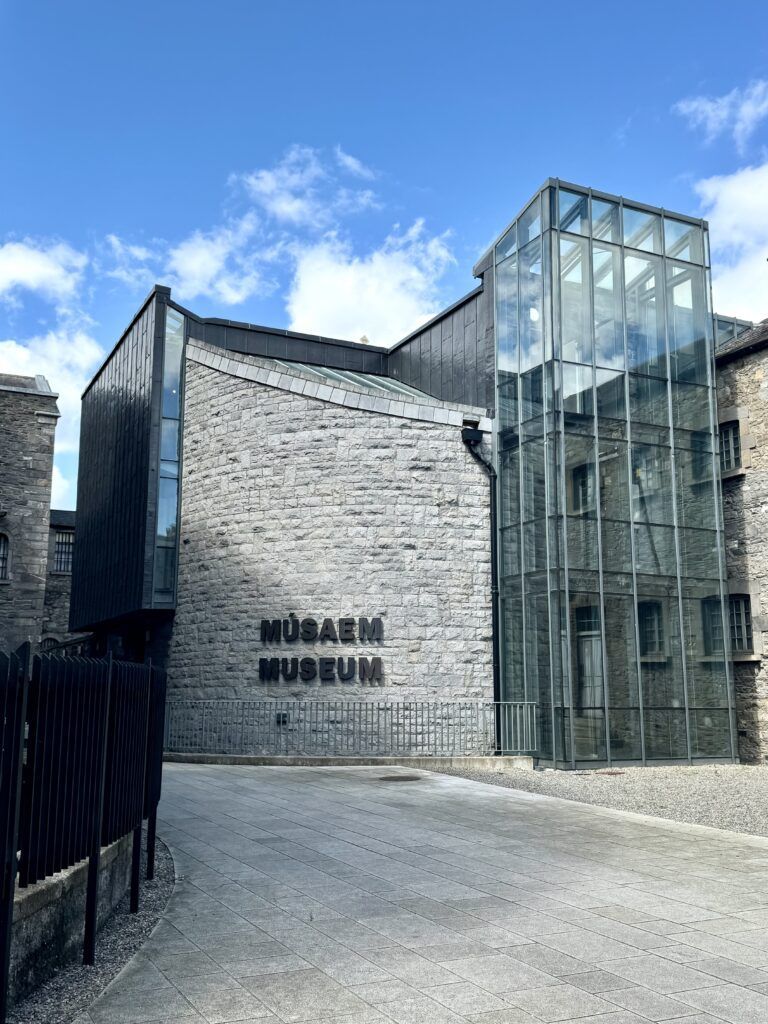
As you walk through the dim, echoing corridors and stand in the cold, cramped cells, you can almost feel the weight of history surrounding you.
The experience will deepen your understanding of this national monument’s significance and its profound place in the Irish soul.
- You can’t visit without pre-booking a timed entry ticket. Access is by guided tour only.
- Tickets are extremely hard to come by. They are released 28 days out at midnight Ireland time. You must set a reminder to buy them or you will be out of luck.
- If you can’t get a ticket, keep checking back for cancellations.
- The guided tour lasts about 1 hour.
- After the tour, you can visit the museum.
- The gaol is a couple miles west of central Dublin and you can walk there in about 40 minutes. There are taxis outside the gaol if you don’t want to walk back.
- It’s an old building, so there are stairs, uneven steps, and low doorways.
Mini History Of Kilmainham Gaol
So why is this jail so famous and a shrine in Irish history?
The gaol was opened in 1796 on a site know as Gallows Hill.
It was intentionally made to look as grimly foreboding as possible. Today, it’s one of the largest unoccupied prison facilities in Europe.
Above the entry door are the Five Devils of Kilmainham, five hissing snakes chained by the neck to represent evil under strict control.
At the time, there were executions every couple months. They were public too, so gawkers could gawk. These were moved inside in 1865.
The gaol’s early days were exceedingly squalid. Victorian Dublin was a place of crowded unsanitary slums, mass unemployment, rampant disease, alcoholism, child abuse, and early death.
The gaol was an all purpose prison for all types of malefactors. The only purpose was confinement, not reform.
At that time, most of the prisoners were debtors or guilty of petty theft, not hardened criminals. Men, women, and children were crammed together in a cell, sometimes 3-5 of them at once.
The prison’s youngest prisoner was either 3 or 7 years old. (I was told conflicting things.) Kids were usually put in the slammer for extremely minor crimes like stealing a loaf of bread.
The prison was as horrific as you can imagine. Neglect was the norm and beatings were commonplace.
The jailers, or turnkeys, were corrupt and biddable.
They often exacted a fee upon entry, fees for favors, and an exit fee. If you were poor, you were stuck with the worst of the worst as you had no money for bribes.
There are essentially two parts of the gaol — the oldest part with narrow, dank, and dark cells and the Victorian wing with a barrel vaulted skylight.
The prison took in leaders of 5 different rebellions — 1798, 1803, 1848, 1867, 1916, the War of Independence (1919-20), and the Civli War (1922-23). The list of inmates is a who’s who of Irish history:
- Charles Stewart Parnell : a leading Irish nationalist political leader and the founder of the Irish Parliamentary Party;
- Robert Emmet : a famous orator and leader of the 1803 rebellion against British rule;
- Eamon de Valera : one of the leaders of the 1916 Easter Rising who was a key political leader in the fight for Irish independence and served as Prime Minister and President of Ireland;
- James Connolly : a socialist and one of the leaders of the 1916 Easter Rising executed by firing squad;
- Patrick Pearse : a leading figure in the 1916 Easter Rising and one of the main authors of the Proclamation of the Irish Republic;
- Joseph Plunkett : another key leader of the 1916 Easter Rising who married his fiancee Grace Gifford in the chapel at Kilmainham Gaol just hours before his execution.
- Constance Markievicz : an Irish revolutionary, suffragist, and nationalist, who became the first woman elected to the British Parliament
The 1916 Easter Rising was the first proclamation of Irish independence, made outside the General Post Office building.
After the Rising, the British sentenced 90 men to death. Ultimately, a firing squad executed 14 of them for treason in the Stonebreaker’s Yard.
The prison was closed in 1924. After a period of abandonment, it was superbly renovated, turned into a museum, and reopened to the public in 1966.
The abandoned prison has an eerie and sacred beauty, with its unique architecture and storied past.
It’s now one of the top tourist attractions in Dublin. And, as I said, it’s hard to get tickets for!
Guide To Kilmainham Gaol: What To See
You start in the chapel with a short film about the jail and its prisoners.
Then, you head to the oldest part of the prison, the West Wing, dating from 1796.
There are long corridors with tiny rooms. They were meant for one prisoner, but sometimes held many more because of overcrowding.
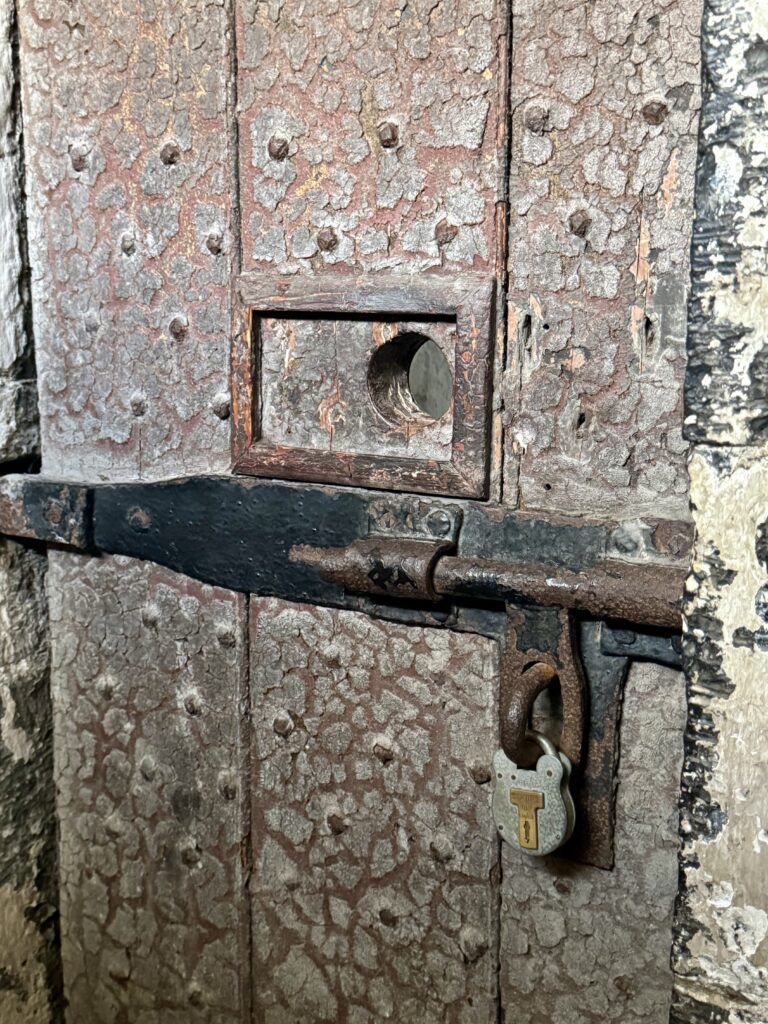
You can step into a couple cells or peep through spy holes, imagining you’re an insurgent or vagrant kept in such horrific conditions.
The cells were very cold. Prisoners were given straw beds or metal cots and a meager bread-based diet.
During the potato famine, conditions were even worse.
Vagrancy was made a crime. Some people committed crimes just to have any chance of a meal insider the jail.
1916 Corridor
This corridor was where prisoners were held before execution.
There are plaques above the doors with their name and graffiti on the walls.
This is where you’ll find the cells of several key figures of the Easter Rising.
The Easter rebels weren’t what you think of as revolutionaries. They were poets, academics, and artists with a dream of a better future without being under the thumb of British imperialists.
Charles Parnell’s Cell
You’ll be able to step inside the cell of Kilmainham’s most famous prisoner, Charles Parnell.
He was a wealthy and privileged prison. He became the leader of the Irish Parliamentary party and uncrowned king of Ireland. In jail, he could wear his own clothes and eat what the governor ate.
A contemporary mural depicts him sitting in a comfy chair chatting to a lady friend before a blazing fire.
Such was his stature that the British government negotiated with him in prison. This resulted in the “Kilmainham Treaty,” which won concessions for Irish tenant farmers.
Kilmainham didn’t just hold Parnell either. They heldd captive his followers and supporters. Kilmainham effectively became a repository for nationalist talent, a finishing school of sorts.
From the gloomy West Wing, you emerge into the frigid light of the Central Hall. It’s a horseshoe-shaped structure built during the Victorian era in 1962, which has been used in quite a few films.
The premise for building the new wing was to separate men and women. In the Victorian era, it was scandalous for the sexes to be promiscuously mixed.
Naturally, when the new wing opened, the women were left behind in the creeky old West Wing and men were given the relative luxury of the new quarters.
The new wing was part of a reform movement.
It finally dawned on philosophers and officials that dumping offenders in a filthy hole might not remedy the situation. Another epiphany was that malevolent criminals should be separated from those that were mentally ill.
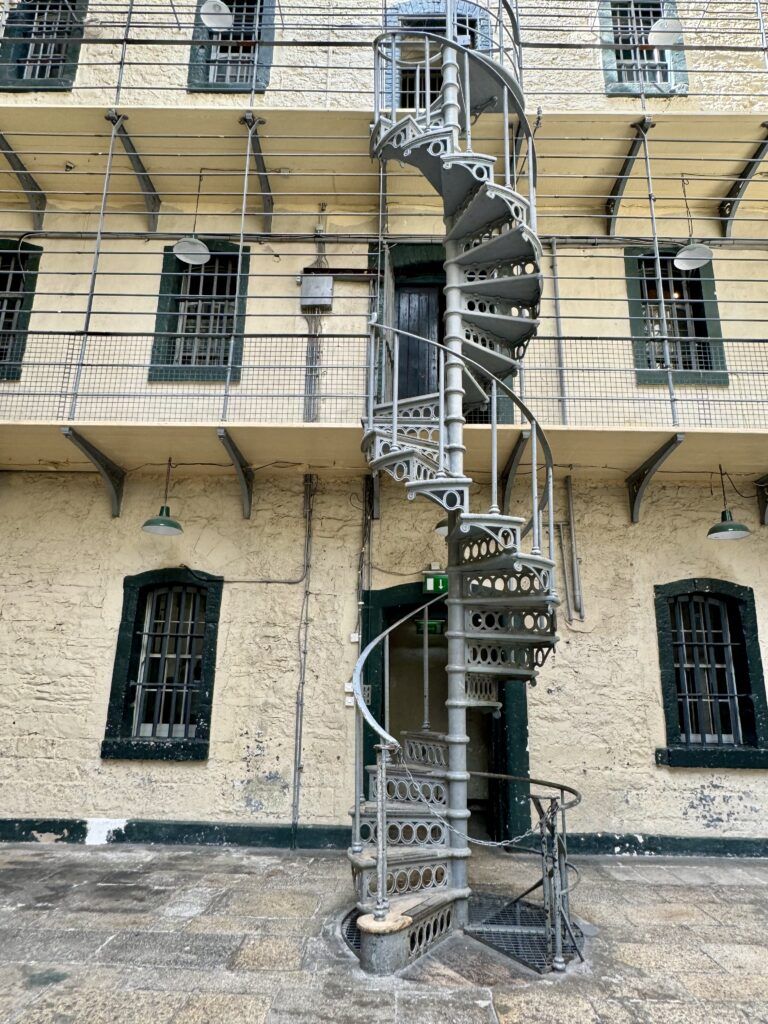
In this wing, 100 cells are stacked in four tiers, under a barrel vaulted skylight. They look inward toward iron catwalks and stairs.
The acoustics were excellent. If you stand in the central viewing platform, like a guard, you can see all the cells — the embodiment of control.
Wardens even muffled the walkways with carpet so prisoners never knew they were being observed.
Each cell had a small window or skylight. Light was thought to rehabilitative and lead to self-contemplation and self-reform. Only the “punishment” cells were devoid of light.
You can walk into several of the cells. One cell has a fresco painted by Grace Plunkett in 1923, the Madonna and Child .
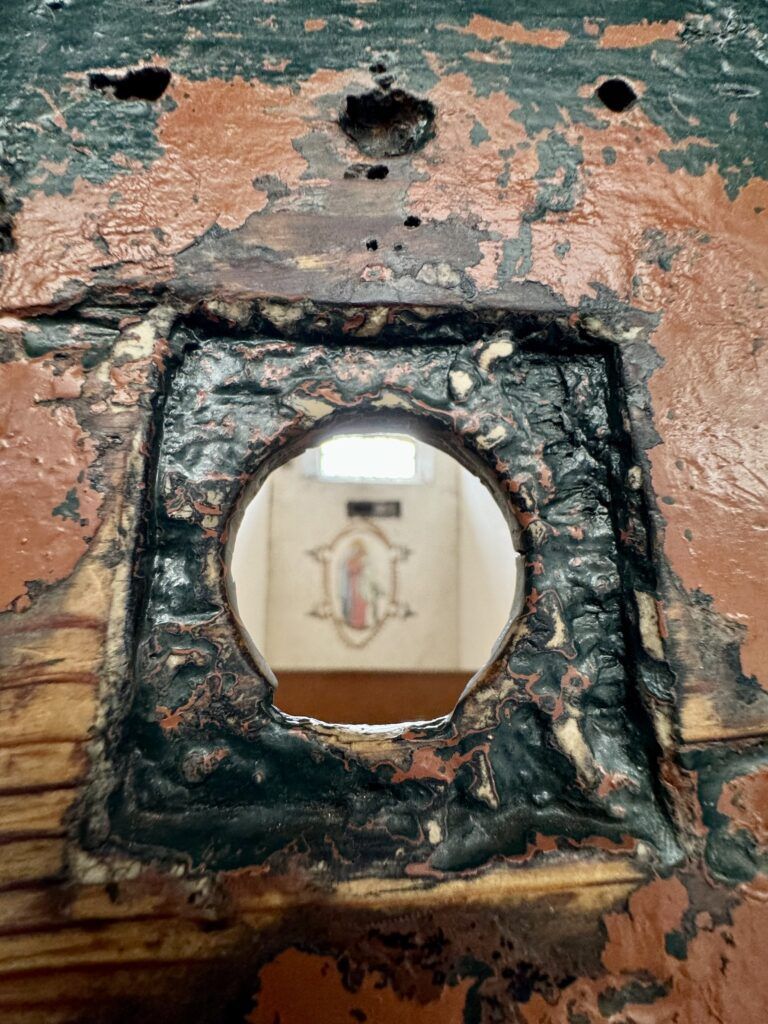
She married Joseph Plunkett, one of the leaders of the Easter Rising, in the jail’s tiny chapel.
They spent 10 minutes together, supervised by British guards.
Two hours later, her bridegroom was shot for treason. She later landed in jail for drawing political cartoons and never married again.
Their tragic love story has become a symbol of the personal sacrifices made for Irish freedom.
Exercise Yard
Outside, you walk through a grim gray enclosure that was an exercise years.
Prisoners could walk 1-2 hours per day in a circle, with their head down and no talking.
This was where one of the prison’s most daring escapes occurred in 1921.
With parts smuggled in from sympathetic British soldiers, 3 men escaped by assembling bolt cutters and slipping through the gates, their cells conveniently left open.
The original gates and locks are in the museum.
Stonebreaker’s Yard
As you move on, you will stand in the most resonant, chilling place on the tour — the Stonebreaker’s Yard. This was the very spot where convicts would break stones for hard labor.
After the Easter Rising was suppressed, this was also where 15 of the Easter Rising leaders were executed, one by one, by British firing squads.
One rebel, James Connolly, was injured and couldn’t stand. He was shot sitting tied to a chair and blindfolded.
Today, a cross marks the spot of their execution and their names appear on a plaque in the courtyard.
The executions ignited public outrage.
As with previous rebellions, the movement’s real significance lay not in its military achievement but in its symbolic power.
Initially, the notion of Irish independence was met with healthy skepticism and deemed a bit cheeky. But the rebels’ “blood sacrifice” quickly turned public opinion in favor of their cause.
The British effectively made martyrs out of rebels. It was incredibly stupid politics.
If the Rising had never happened, the history of Ireland would be different. Instead, an old order died, launching a transformative time for Ireland.
In a compelling phrase in his great poem Easter 1916 , W.B. Yeats wrote, “All changed, changed utterly: A terrible beauty is born.”
A striking sculpture representing those executed, complete with bullet holes, sits across the road from the gaol.
As Winston Churchill once said, “Grass grows over a battlefield, never over a scaffold.”
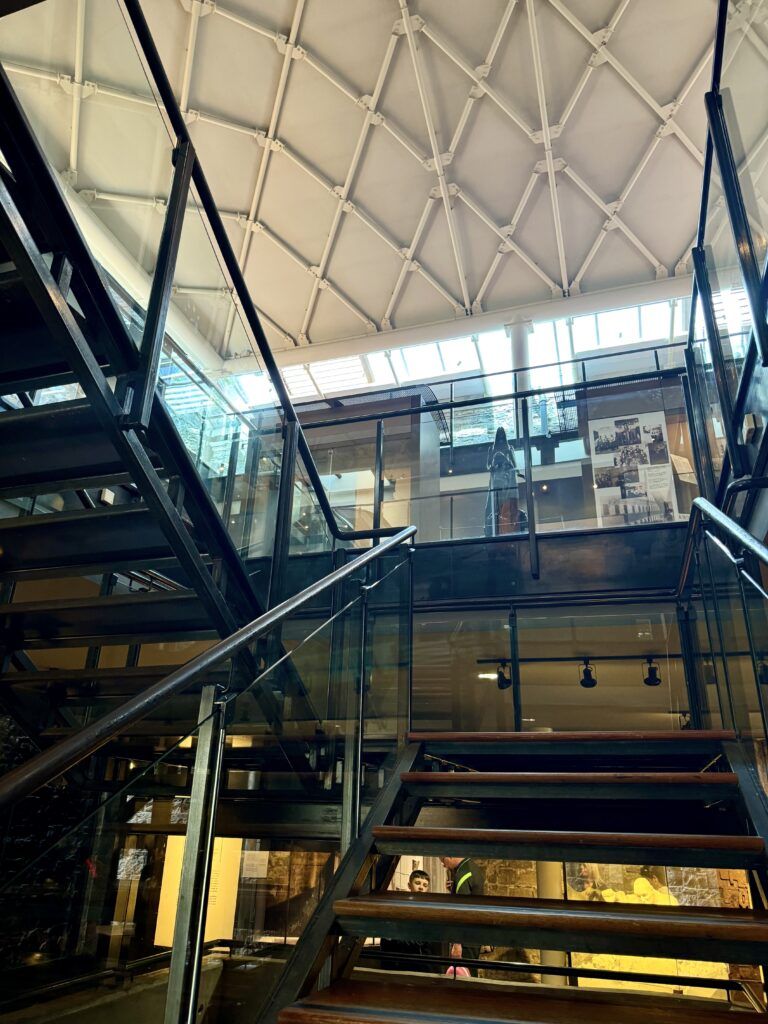
You end your visit in the museum, which is fittingly industrial style black and gray. It’s laid over two levels.
You’ll get the entire history of the jail, its famous inmates, and the Irish rebellions that created a free nation. There are artifacts, photographs, and detailed infographics.
There are also multi media guides. You can even peak in to see a poor prisoner in solitary confinement.
I would plan to budget at least an hour here to read all the info.
Practical Guide & Tips For Kilmainham Gaol
Address : The jail is in an inner suburb of Dublin, Kilmainham, at Inchicore Road 8.
Hours : Open year round (except December 24-27) from 9:30 am to 5:15 pm (last tour 4:15 pm).
Parking : Kilmainham Gaol has no car parking facilities. Parking is available at the nearby Irish Museum of Modern Art/Royal Hospital Kilmainham – access via East Gate, Military Road.
The ticket price is 8 euros, quite reasonable I thought. You can only buy a ticket on the official website . The jail doesn’t sell tickets through third party vendors like Get Your Guide.
In fact, the gaol says: “Tickets bought from other sites, including ticketing resale platforms, will not be valid and such ticket-holders will be refused entry.”
If you can’t buy a ticket, keep checking back online for cancellations frequently.
These will be released online between 9:15 am – 9:30 am Ireland time. This was the only way I was able to visit!
I hope you’ve enjoyed my guide to Kilmainham Gaol. You may find these other Ireland and UK guides useful:
- beautiful places to visit in Ireland
- what not to do in Ireland
- 1 day in Belfast itinerary
- guide to St. Patrick’s Cathedral
- 3 days in London itinerary
- 5 days in London itinerary
- b est day trips from London
Pin it for later.
Last Updated on September 6, 2024 by Leslie Livingston
Tickets & prices Kilmainham Gaol
- Homepage Homepage
Kilmainham Gaol
- Current: Tickets & prices
Admission prices & discounts for tickets to Kilmainham Gaol in Dublin
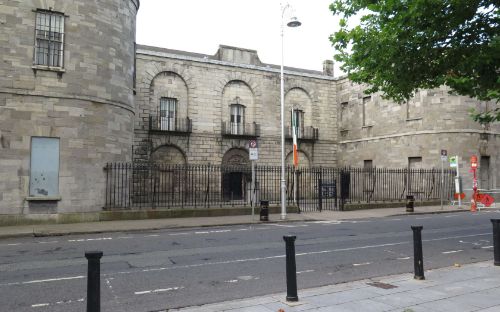
The following overview lists the admission prices and various discounts and discount codes for a visit to Kilmainham Gaol in Dublin . All prices are displayed per age group or reduced rate group. You can also directly book your discounted online ticket for the Kilmainham Gaol here, if available, or make a reservation to reserve a timeslot if applicable.
- #7 in Ireland
- #7 in Dublin
- View best museums in Europe
Wondering what a ticket to Kilmainham Gaol costs? These are the prices:
Ticket prices & discounts
Groups (min 10 people/max 35 people) must be pre-booked in advance by emailing [email protected] Group (adults) €6.00 per person Group (students) €4.00 per person
Tours & tickets near Kilmainham Gaol
Here are some tours and tickets near Kilmainham Gaol, including discount cards & passes, skip the line tickets and tickets to events & activities in Dublin.
Book now →
These cards and discount passes are available in Dublin: Dublin Pass .
More about Kilmainham Gaol
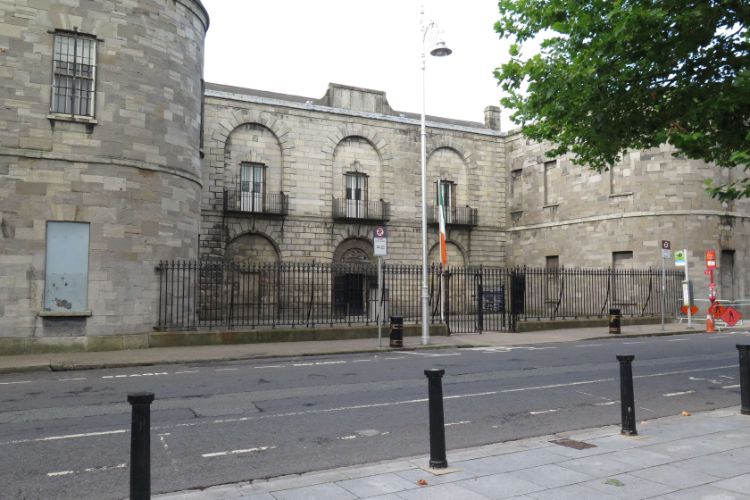
Heritage Ireland
Kilmainham gaol museum.
BOOK ONLINE
See all opening times
Please note that no third-party organisations are authorised to sell tickets to Kilmainham Gaol. Tickets bought from other sites, including ticketing resale platforms, will not be valid and such ticket-holders will be refused entry. Furthermore, we are aware that there are fraudulent websites purporting to www.kilmainhamgaolmuseum.ie . These websites and domain names look similar, but have no connection whatsoever to the Office of Public Works or Kilmainham Gaol. We urge extra vigilance, as any tickets purchased from fraudulent sites cannot be honoured.
The only legitimate website to purchase tickets from for this site is www.kilmainhamgaolmuseum.ie.
Adult €8 Senior (60+): €6 Child (12-17): €4 Child (under 12): Free but require a ticket Student (valid student ID required): €4 Family (Two adults & 2/3 children 12-17): €20
Pre-booking tickets online is essential.
Please note that no third-party organisations have authorisation to sell tickets to Kilmainham Gaol. Tickets bought from other sites- including ticketing resale platforms -will not be valid and such ticket-holders will be refused entry.
Furthermore, we are aware that there are fraudulent websites purporting to www.kilmainhamgaolmuseum.ie . These websites and domain names look similar, but have no connection whatsoever to the Office of Public Works or Kilmainham Gaol. We urge extra vigilance, as any tickets purchased from fraudulent sites cannot be honoured.
For wheelchair users or visitors who require special assistance please email [email protected] in advance of booking. Group bookings (10 tickets+) please email [email protected]
Getting here
Inchicore Road, Kilmainham, Dublin 8 D08 T2X5
Get Directions
Kilmainham Gaol is one of the largest unoccupied gaols in Europe. It opened in 1796 as the new county gaol for Dublin and finally shut its doors as such in 1924. During that period it witnessed some of the most heroic and tragic events in Ireland’s emergence as a modern nation.
Among those detained – and in some cases executed – here were leaders of the rebellions of 1798, 1803, 1848, 1867 and 1916, as well as members of the Irish republican movement during the War of Independence and Civil War.
Names like Henry Joy McCracken, Robert Emmet, Anne Devlin and Charles Stewart Parnell will always be associated with the building. Not to be forgotten, however, are the thousands of men, women and children that Kilmainham held in its capacity as county gaol.
Kilmainham Gaol is now a major museum. The tour of the prison includes an audio-visual presentation.
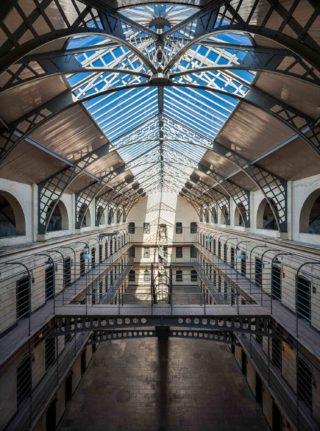
Opening Times
Open All year .
Closed 24, 25,26 and 27 December
Daily access by guided tour only. Pre-booking is essential. Please allow 90 minutes for your visit. As part of the tour is outdoors, visitors should dress appropriately for the weather.
Please note that this is a very busy site all year round and visitors may experience delays at certain times. During winter months the interior of the Gaol is very cold — please dress appropriately.
01 453 5984
By Car – Public car park close to site.
By Bus – Take the X8 to Cashel and walk 500m from the centre of Cashel town off the Dublin Road.
By Train – The nearest train station is Thurles.
Click the relevant icon below to open Maps directions
Getting Here
3.5km from centre of Dublin.
Open location in Google Maps
Facilities Restrictions
- Baby Changing
- Bicycle Parking
- Card Accepted
- Guided tours
Restrictions
- Access by Guided Tour Only
- Assistance dogs only
- Hold hand rail
- Uneven walkways
Social Guide
Download, print and read our social guide (PDF) about visiting Kilmainham Gaol. This will help first-time visitors, families and people with developmental and learning disabilities to prepare for a visit to Kilmainham Gaol.
Download the Social Guide (Covid-19)
Nearby sites to visit
Irish national war memorial gardens.
Relax and reflect in this beautiful garden monument
Approx. 0.5 km from Kilmainham Gaol Museum
Royal Hospital Kilmainham
One of Dublin's most iconic buildings and Ireland’s foremost example of fine 17th century architecture
Approx. 0.7 km from Kilmainham Gaol Museum
Phoenix Park – People’s Flower Gardens
Enjoy Victorian floriculture at its best
Approx. 1.1 km from Kilmainham Gaol Museum
You might also like
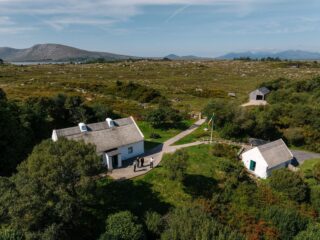
Ionad Cultúrtha an Phiarsaigh Conamara- Pearse’s Cottage and Visitor Centre
A cottage steeped in revolutionary history and Gaelic culture

Pearse Museum – St. Enda’s Park
An enthralling chapter in the story of 1916
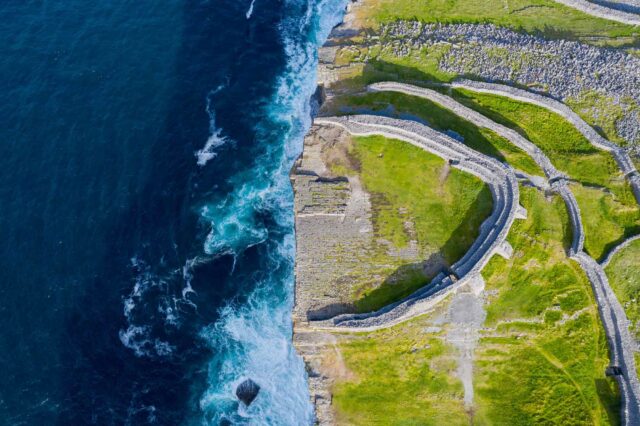
Heritage Card
Unlimited access to Ireland’s past
Buy one today
Join our mailing list
Are you happy to receive marketing material via email from Heritage Ireland
You can unsubscribe at any time. For information about our privacy policy, please visit our Privacy Policy
- Click to open search
- Open the main navigation
Kilmainham Gaol
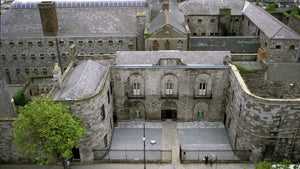
- Family friendly
- Pre-booking essential
Dublin's Kilmainham Gaol held some of the most famous political and military leaders in Irish history such as Robert Emmet, Charles Stewart Parnell, the 1916 Rising leaders and Eamon de Valera.
If for no other reason, Kilmainham Gaol in Dublin would be remarkable for being the biggest unoccupied gaol in these islands. As such, it gives the visitor a dramatic and realistic insight into what is was like to have been confined in one of these forbidding bastions of punishment and correction between 1796 when it opened and 1924 when it closed. It offers a panoramic insight into some of the most profound, disturbing and inspirational themes of modern Irish history. Leaders of the rebellions of 1798, 1803, 1848, 1867 and 1916 were detained and sometimes executed here. The Gaol also played a role during the harsh Famine times.
The visit includes a 1 hour guided tour and exhibition. It is a very busy site. Pre booking online is essential. You don't need to print out tickets, just retain your order number.
Only the ground floor is wheelchair accessible and a ground floor tour can be organised if needed; please email (don't book online in this case).
Buggies are not permitted on the tour and it is not really appropriate for younger children under 6 years.
Information leaflets are available online in English, Gaeilge, Español, Italiano, Deutsche, and Français.
Please see the website for information on temporary exhibitions.
Paid parking is available at the nearby IMMA for a small fee.
If you are unable to do a tour, you are free to visit the museum section and to enjoy the café on site.
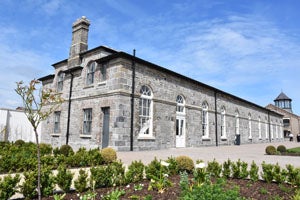
Sat, 14 Sep
Richmond Barracks

The Kilmainham Gaol Tour: One Of The Best Tours In Dublin (All You Need To Know)
By Author James March
Posted on Last updated: December 31, 2023
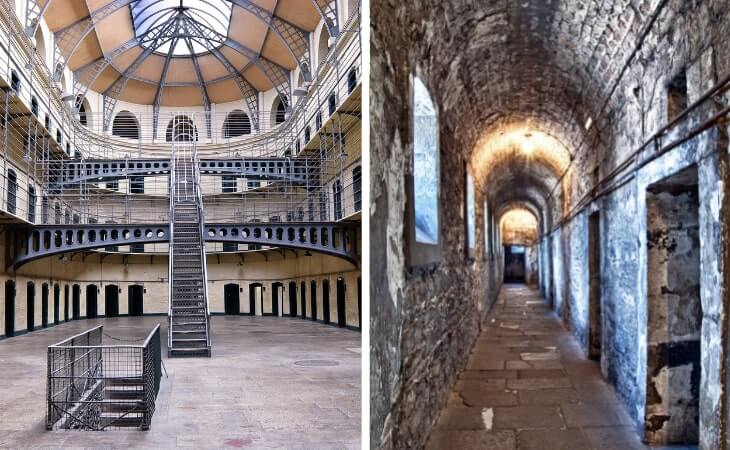
A visit to Kilmainham Gaol (Jail) is arguably one of the best things to do in Dublin .
Built back in 1796 and initially known as the ‘new gaol’ in order to differentiate it from the dungeon it was replacing, the Kilmainham Gaol Museum is a fascinating place to explore.
Over the course of its life as a working prison, it housed many a notable name while also playing witness to the executions of several leaders of the 1916 Rising.
Below, you’ll get the lowdown on the Kilmainham Gaol tour, where to grab parking, how to get there via public transport and more handy info.
Table of Contents
Some quick need-to-knows about Kilmainham Gaol
Although a visit to the Kilmainham Gaol Museum is fairly straightforward, there are a few need-to-knows that’ll make your visit that bit more enjoyable.
1. Location
As you might have guessed by its name, Kilmainham Gaol is located in Kilmainham… It’s a 15-minute walk from the Irish Museum of Modern Art and a 25-minute walk from both the Phoenix Park and the Guinness Storehouse .
2. Opening hours
The Kilmainham Gaol opening hours differ slightly, depending on what time of year you visit (though the time differences are so small that they shouldn’t affect your itinerary too much).
- September to June: 9:30 – 17:15
- July & August: 9:30 – 17:30
3. Admission
Not only is Kilmainham Gaol one of the best museums in Dublin – it’s one of the most fairly priced, too (especially as the tour is guided). Kilmainham Gaol tickets will set you back:
- Adult: €8
- Senior 60+): €6
- Student: €4
- Child (12-17): €4
- Family (Two adults & 2-3 children 12-17): €20
Though there are no car parking facilities at Kilmainham Gaol, parking is available at the nearby Irish Museum of Modern Art/Royal Hospital Kilmainham. Access is via East Gate on Military Road. The car park is just a 5-minute walk to the Gaol.
5. Getting there by public transport
There are four Dublin buses that drop you close to the Kilmainham Gaol museum so consider jumping on any of these:
- No. 69, 79 from Aston Quay, Dublin 2
- No. 13 & 40 from O’Connell Street , Dublin 1, or College Green Dublin 2
- If you’d prefer to go by the Luas Tram, then take the red line. Your nearest stop will be Suir Road
Kilmainham Gaol history

Photos via Shutterstock
Dublin’s infamous prison was built back in 1796 and was initially known as the ‘new gaol’ in order to differentiate it from the dungeon it was replacing.
Despite the new premises, conditions inside Kilmainham weren’t a whole lot better. With no segregation of prisoners, men, women and children were incarcerated together, with up to 5 in each cell and only a single candle for light and heat.
The poor conditions meant that most of the prisoners’ time was spent in the cold and dark, while each candle had to last for up to two weeks.
Things would eventually get a little warmer for certain adult prisoners who would be transported to Australia as convicts.
Irish Nationalism and 1916
From the beginning, the prison had powerful ties to Irish Nationalism and actually housed its first political prisoner in the same year that it opened!
Seven years later, the leader of the 1803 Irish rebellion, Robert Emmet, was incarcerated at Kilmainham before being hanged for high treason.
But Kilmainham is probably most famous for its role in the imprisonment and executions of the leaders of the 1916 Easter Rising . Of the 90 people sentenced to death, fifteen were executed at Kilmainham, including Proclamation of the Republic signatories Patrick Pearse, Thomas Clarke and James Connolly.
Restoration and life as a museum
Following the end of the Irish Civil War, the prison closed due to it being seen as the symbol of oppression and a difficult past.
While interest in re-opening the prison as a museum to Irish Nationalism was strong, over 40 years passed before Kilmainham was able to be restored, and it finally opened to the public in April 1966.
These days, Kilmainham Gaol is one of the biggest unoccupied prisons in Europe and it’s one of the most evocative symbols of Dublin and Ireland’s turbulent history.
Things you’ll discover on the Kilmainham Gaol tour
One of the reasons the Kilmainham Gaol tour is one of the most popular places to visit in Dublin is due to the sheer number of things there is to see and do.
Below, you’ll find info on the various corners of the building you’ll explore and the stories you’ll hear on the Kilmainham Gaol tour.
1. The building

Taking 10 years to build, construction began on the new gaol in 1786 and would cost the Grand Jury of the County of Dublin £22,000 by the time it was finished (a hefty sum of money in those days!).
The gaolers lived in the central front block, while the two wings contained cells for the prisoners. The interior buildings and yards are surrounded by a thick wall which measures between 30′ and 50′ depending on its location, while the main entrance was the formidable doorway (with the five snakes above it).
Just outside this entrance was where public hangings took place until the late nineteenth century and remains of the fixtures for the gallows can still be seen.
2. Prison life

Photo by matthi (Shutterstock)
As we touched on earlier, conditions at the prison were pretty squalid despite being billed as a higher quality replacement for the old gaol (not to mention the cost!).
The same problems that dogged the old gaol raised their ugly head again at Kilmainham, mainly thanks to the overcrowding, which led to disease and poor hygiene.
The famine years were particularly bad, and food rations during this period were particularly low. Yet amazingly, people were committing crimes to be allowed entry into the prison due to the small amount of regular food available.
Prisoners also worked within the Gaol. A sentence of hard labour for a man consisted of manually breaking stones in the Stonebreakers’ Yard, and for women meant working in the laundry.
3. The transportation of convicts

Ironically, the main reason the gaol suffered from overcrowding was due to people waiting to leave. From the time it opened until the early 1850s, Kilmainham Gaol was used as a depot for convicts from the northeast of Ireland who had been sentenced to transportation to Australia.
Here they would wait before being transferred to a port in either Dublin or Cork, where they would board great convict ships bound for Australian penal colonies.
Over 4,000 prisoners were processed through Kilmainham during this period, and most of them were either petty criminals or political prisoners.
4. The turbulent 1910 – 1924 period

The 14 years between 1910 and 1924 represented what Kilmainham would eventually become most famous for. From the height of overcrowding in the mid-19th century, the last two decades of the century actually saw a decline in the prison population, and Kilmainham was closed as a money-saving exercise by the government.
In 1910, those in Kilmainham were transferred to Mountjoy Prison, and a year later, Kilmainham Gaol was handed over to the military (the British Army) for their use from then on.
From the outbreak of World War I in 1914, they used it as living quarters for new recruits and as a military detention centre for soldiers.

5. The executions

Taking advantage of Great Britain’s resources being ploughed into the war, the Easter Rising of 1916 took place when the enemy was at its most distracted.
After six days of fighting, the Irish rebels eventually surrendered, and many were incarcerated in Kilmainham.
Between the 3rd and 12th of May 1916, fourteen men were executed by firing squad in the Stonebreakers’ Yard of Kilmainham Gaol.
Seven of them had been the signatories of the Proclamation and their names are all still significant today. They were Thomas Clarke, Seán Mac Diarmada, Thomas MacDonagh, Patrick Pearse, Éamonn Ceannt, James Connolly, and Joseph Plunkett.
Things to do near the Kilmainham Gaol Museum
One of the beauties of the Kilmainham Gaol tour is that, when you finish up, you’re a short walk from some of the best places to visit in Dublin .
Below, you’ll find a handful of things to see and do a stone’s throw from the Kilmainham Gaol Museum (plus places to eat and where to grab a post-adventure pint!).
1. Irish National War Memorial Gardens (12-minute walk)

Photo by Patrycja St (Shutterstock)
To learn about some more people (many more, in fact) who gave up their lives in the name of freedom and their country, make the short 12-minute walk over to the Irish National War Memorial Gardens. Designed by Sir Edwin Luytens, it’s a peaceful handsome spot featuring a domed temple and sunken gardens.
2. Irish Museum of Modern Art (15-minute walk)
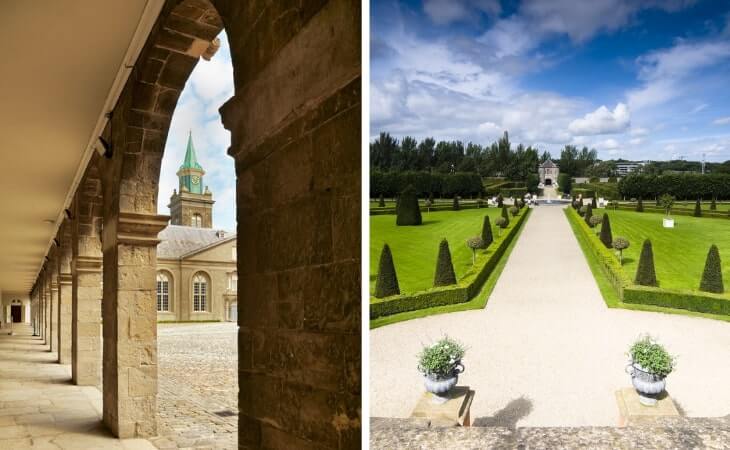
Located in a renovated 17th-century hospital just 15 minutes from the Kilmainham Gaol tour, the Irish Museum of Modern Art is home to the National Collection of Modern and contemporary art, with over 3,500 artworks by Irish and International artists. The mix of vivid modern art within the historic walls of the old hospital is a clash of the senses and makes for a really interesting visit.
3. Phoenix Park (23-minute walk)

If you want some fresh air after the tour or if your head needs a little clearing, there’s no better place to do that than Phoenix Park . One of the largest city parks in Europe, it’s a pleasant 23-minute walk away just across the Liffey and there are a bunch of interesting sights inside, such as the Wellington Monument and Dublin Zoo .
4. Guinness Storehouse (22-minute walk)
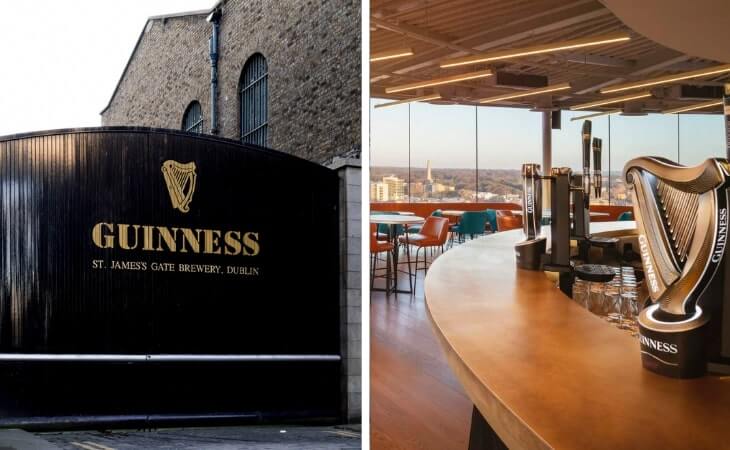
Courtesy Diageo Ireland Brand Homes via Ireland’s Content Pool
If you’d like to raise a glass to Pearse and Connolly at Ireland’s most iconic brewery, then make the 22-minute walk east over to the Guinness Storehouse . While learning about the history, the brewing process and the legendary adverts is great. It’s the rooftop bar that really makes the Storehouse a cracking visit.
FAQs about Kilmainham Gaol in Dublin
We’ve had a lot of questions over the years asking about everything from ‘Why is Kilmainham Gaol famous?’ (for its historical significance) to ‘Is the Kilmainham Jail tour worth doing?’ (it is!).
In the section below, we’ve popped in the most FAQs that we’ve received. If you have a question that we haven’t tackled, ask away in the comments section below.
How long is the Kilmainham jail tour?
You’ll want to allow around 1.5 hours to get through the entire Kilmainham Gaol museum tour. This includes checking in time.
How much does it cost to visit Kilmainham Gaol?
Kilmainham Gaol tickets are €8 for adults, € for seniors (60+), €4 for students and kids aged 12 to 17. There’s also a family ticket for €20.
Is the Kilmainham Gaol Museum really worth going to?
Yes – the Kilmainham Gaol tour is absolutely fantastic and it’ll grip you from start to end. Expect many tales, legends and Kilmainham Gaol facts.
This site uses Akismet to reduce spam. Learn how your comment data is processed .
Monday 6th of May 2019
OMG YES!! I can't stress enough how absolutely AMAZING this tour was, perhaps even the best of my entire trip which included other wonderful places in Ireland, as well as Scotland and France. It was a sort of last minute decision and I was the only one in my group who knew any of the history surrounding the Kilmanhaim Gaol but every single person in my group LOVED the tour and learned so much from the extremely knowledgeable tour guides. At the end there is a small museum, don't miss the letter from a 17 yr old young man to his mother before he is executed. It haunts me to this day and I have such enormous respect and admiration for every brave soul that fought tirelessly for their beloved free Ireland.
Tuesday 7th of May 2019
Glad you enjoyed it Karen. It's been a couple of years since I last did it. Thinking about visiting the weekend after next! Great spot!
Kilmainham Gaol Museum - Plan Your Visit
- Get an insight into what life was like under lock and key at this famous prison!
- Visit the Catholic chapel inside the prison, where a leader of the Easter Rising married his fiancée hours before execution.
- Discover over 200 years of history at Kilmainham Gaol
- Learn how the prison played a key role in definitive events in Ireland's history.
A Dublin Attraction like no other - Kilmainham Gaol
Located just a short distance from Dublin City, Kilmainham Gaol offers visitors an up-close look back through defining moments in Ireland’s history.
The history of modern Ireland is all around the walls of Kilmainham. Political prisoners were kept in the prison (and sometimes executed, too) from the 1798 Rebellion to the Irish Civil War of 1922-23. The prison also housed thousands of ordinary people from all over Ireland, jailed for all sorts of crimes and waiting to be transported to Australia.
The prison is divided into two wings. The older one, the West Wing, survives in its original state. This was home to political prisoners and the poorest criminals – often jailed for stealing food during the Famine.
The East Wing is light-filled and airy by comparison – but by no means luxurious. Its metal walkways and clanging cell doors are a classic jail set-up where guards can watch inmates at all time.
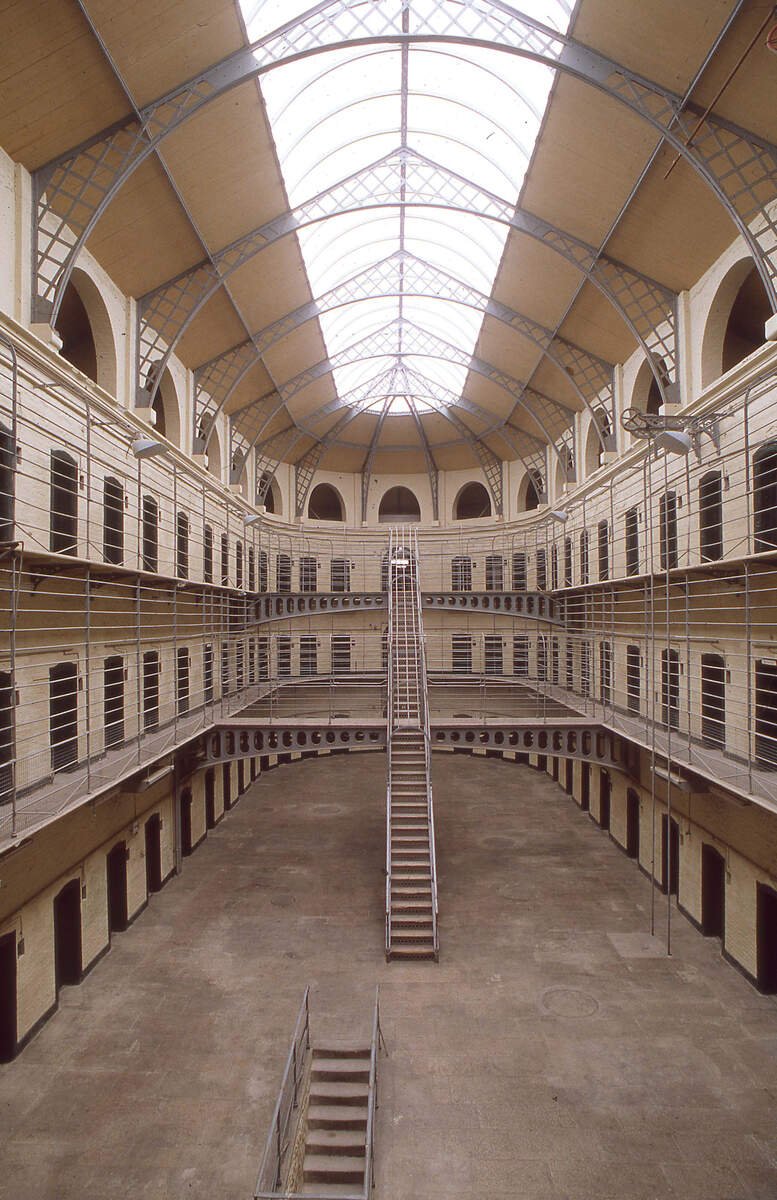
Guided Tour at Kilmainham Gaol
The guided tours at Kilmainham Gaol offer a panoramic insight into some of the most defining and inspirational events of modern Irish history. Leaders of the rebellions of 1798, 1803, 1848, 1867 and 1916 were detained and sometimes executed here. The Gaol also played a role during the harsh Famine times.
Your guided tour is approximately 1-hour, and this includes the exhibition. Pre-booking online is essential. You don't need to print out tickets, just retain your Order number.
Tickets for Kilmainham Gaol Tours
You can buy tour tickets from the Kilmainham Gaol Museum website.
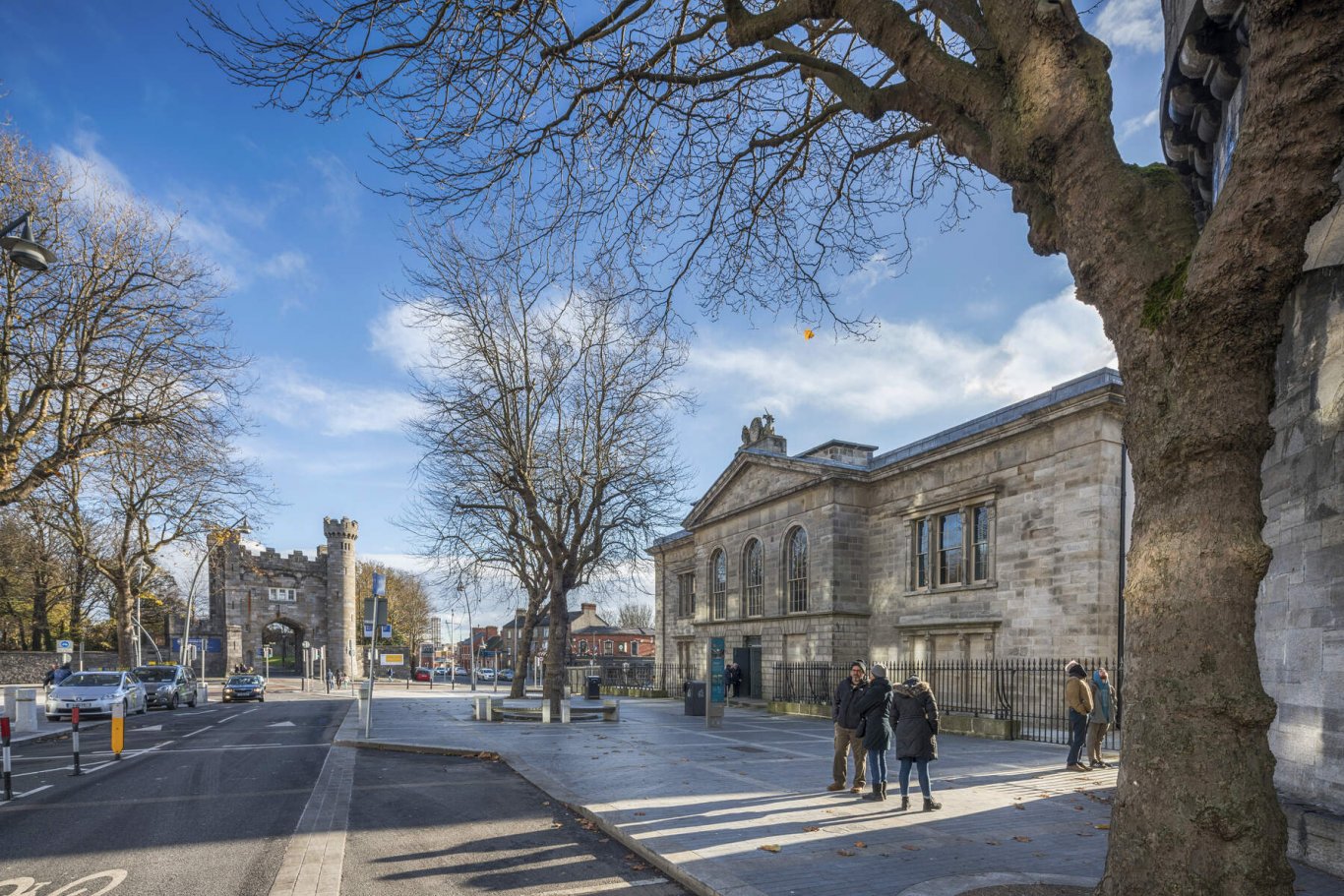
Kilmainham Gaol in FIlm
Movies such as The Quare Fellow (1962), The Italian Job (1969), and The Last Remake of Beau Geste (1977) were all partially filmed at the Gaol. They also received huge popular support from tradesmen, having as many as 200 working pro bono on the site at evenings and weekends during the 1960s.
Kilmainham Gaol has also continued to feature prominently as a film location, with movies such as In The Name of the Father (1993), Michael Collins (1996), The Escapist (2008), and the recent Rebellion drama by RTÉ all shot within the building.
Where is Kilmainham Gaol?
Kilmainham Gaol Museum is located 3.5km west from Dublin City.
Hop-On Hop-Off Tour
Due to its location and distance from the city, The Hop-On Hop-Off Tour is a great way to get to Kilmainham Gaol. DoDublin Tours have a designated stop outside Kilmainham Gaol. City Sightseeing Tours and Big Bus Tours have a stop closeby also.
Dublin Bus Routes 69 & 79 from Aston Quay, or Routes 13 & 40 from O’Connell St or Dame St. Visit the Dublin Bus website for details.
Kilmainham Gaol is on the outskirts of the city, and is 3km from Temple Bar. If you choose to walk, it is a nice opportunity to walk along the Liffey. We also suggest taking a wander through Royal Hospital Kilmainham and its beautiful gardens on the way. The side entrance to the Royal Hospital will take you to Kilmainham Gaol.
There is a Dublin Bike station right outside the museum. If you are cycling in the area, it's a good opportunity to explore the vast Phoenix Park nearby!
Suir Road is the closest Luas stop - this is 750 metres away.
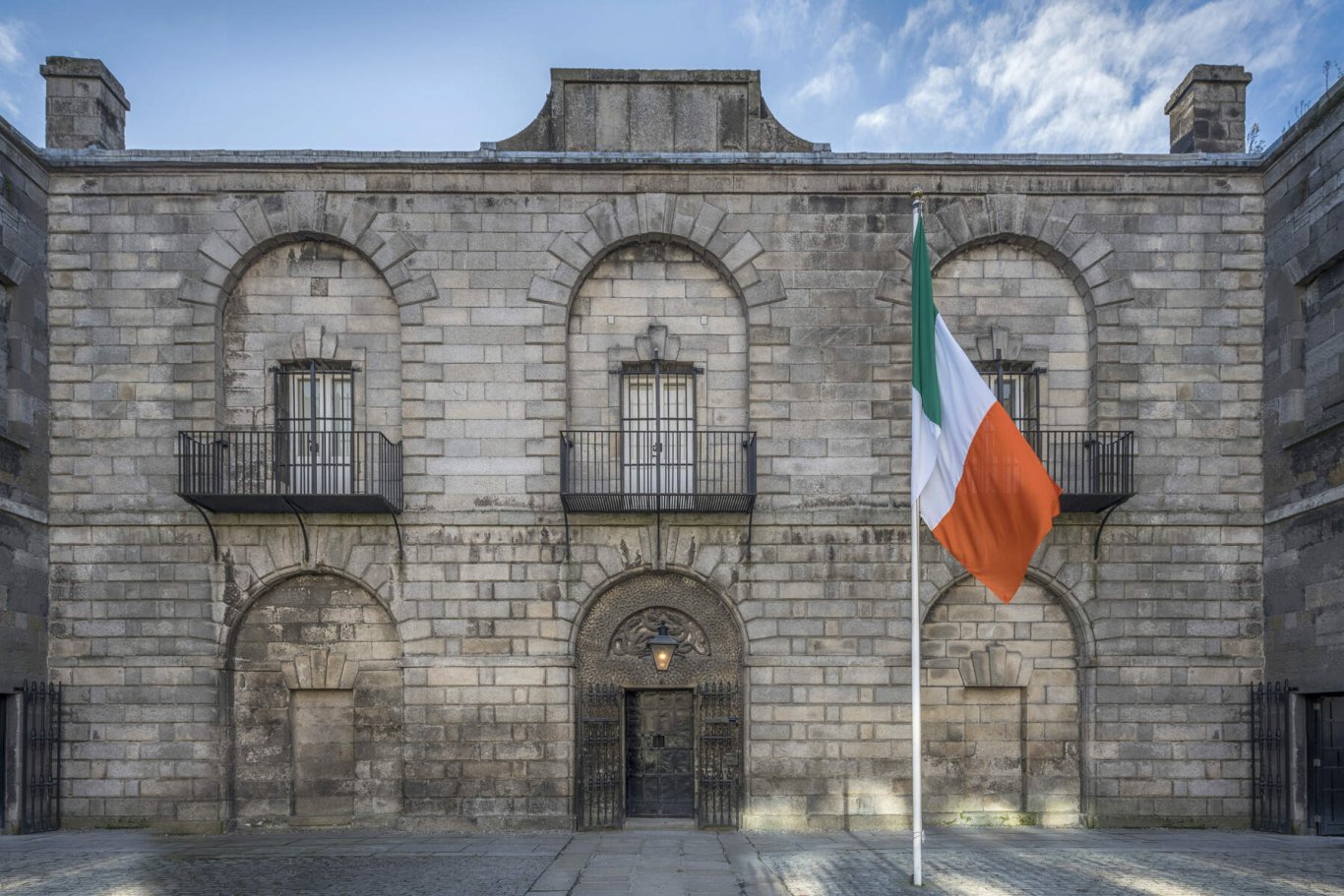
Closeby attractions include the Guinness Storehouse - Ireland's most popular visitor attraction, and Pearse Lyons Distillery .
Follow the link to book the Kilmainham Gaol Museum

- Washington D.C.
- Private Tours
Easy Access – Kilmainham Gaol, War & Revolution Tour
- Instant Confirmation
- 24 Hour Cancellation
- Explore and experience Irish history during an entertaining and engaging walking tour of Kilmainham Gaol, unchanged since 1924
- Enjoyed Timed Entry tickets to Kilmainham Jail
- Visit The Irish National War Memorial Gardens dedicated to the memory of the Irish soldiers who gave their lives in WWI
- Experience what life was like during the many Irish uprisings and WWI & WWII in Ireland
- Hear about the historical events that changed the course of Irish history from the 13th century to the present day
- Visit the actual prison cells and execution site of the Leaders of the 1916 uprising
- Enjoy the most extraordinary tour led by an expert local English-speaking guide
- Small groups of 20 people or fewer
Description
Learn about some of the most important events in Irish history and hear stories of great personal sacrifice and triumph on our extraordinary Kilmainham Gaol, War and Revolution Tour. We combine a fully guided Kilmainham Gaol tour with a fully guided visit to The Irish National War Memorial Gardens, dedicated to the memory of Irish soldiers who gave their lives in the Great War of WWI. With an expert guide on hand throughout (specially chosen for their knowledge and passion of this fascinating period in Irish history), you’ll discover how the Irish were governed for over 700 years by the English and the ensuing political and revolutionary events that’s shaped the Ireland of today. Travel through time to really understand the political heart of the Irish people and its leaders including Michael Collins played by Liam Neeson in the movie of the same name that was also filmed in part at Kilmainham Gaol.
The tour begins with a guided walking tour of Kilmainham Gaol to discover its fascinating history and the role it played in rallying the Irish people to pursue independence from Great Britain and Westminster. Once inside the jail you’ll discover its dark history while walking in the footsteps of many of its many inmates, including; men, women and children. Explore Irish and English politics while your professional and engaging OPW Kilmainham Gaol guide tells you about some of its more famous inmates including the Leaders of the 1916 Rising, not only men but women too including Countess Markievicz an Irish politician, revolutionary, nationalist, suffragette and socialist who was imprisoned in Kilmainham Gaol awaiting execution as a result of her participation in the 1916 Rising. You’ll see and visit some of the cells of its most famous inmates as well as some of its youngest.
With small groups of only 20 people or fewer, our Kilmainham Gaol, War & Revolution Tour will be personal and unhurried, with a passionate and friendly guide. Walk over history while discovering the main places and players that shaped the Ireland of today.
Finally, you will also enjoy the Gaol’s film history where the following movies were filmed;
The Italian Job, The Adventures of Young Indiana Jones, The Babe, Michael Collins, In the Name of the Father
Good to Know
- Tour includes €8 ticket for timed entry to The Gaol.
- This tour is led by an expert local English speaking guide, with the Official Kilmainham Gaol tour conducted by an OPW Kilmainham Jail Guide.
- Experience over 200 years of Irish history dramatized in extraordinary guide stories.
- See a fascinating audio visual show detailing the history of this significant building.
- Visit & see the actual prison cells of the largest preserved Victorian jail in Europe.
- Visit the execution site of the leaders of the 1916 Easter Rebellion.
- Walk the narrow cell corridors that have strong connections to the Irish struggle for independence.
- Entrance and fully guided tour of the Irish National War Memorial Gardens.
- See the banks of the River Liffey which witnessed the very first landing of the 9th Century Viking invasions.
- Hotel Pick Up / Drop-Off
- Transportation
- We cannot accommodate strollers or baby carriages.
- Wheelchairs, motorized scooters, or any other device to assist mobility are not recommended.
- Participants should be in good health, consult first with your doctor if you have any medical condition or are not used to regular exercise.
- Wear comfortable shoes as this tour involves a fair amount of walking, including over uneven surfaces, cobblestones, hills, inclines/declines and stairs.
- Operates in all weather conditions, please dress appropriately.
- Changes or cancellations requested less than 24 hours before the tour departure time are not possible.
- Anybody under the age of 18 years must be accompanied by an adult.

LetzGo City Tours is an exciting, innovative tour company offering extraordinary premium group tours of some of the most exciting cities of the world.

LetzGo City Tours is not responsible for content on external Web sites or links.
- Useful Maps
- Ask About Ireland
- Ireland & the Irish
- Ireland with Kids
- Ireland on a Budget

Kilmainham Jail

Built in 1796, Kilmainham Gaol (or Kilmainham Jail) has an unique place in Irish History and was where for more than 100 years those who fought against the English occupation of Ireland were imprisoned and where many of them died.
It is a sombre, even chilling, place to visit, but absolutely fascinating.
There is a heavy emphasis during the tour here on putting the gaol in its historic context and visitors will leave with a much deeper understanding of the often complex forces which shaped the Irish nation.
Kilmainham Gaol: The Building
There are two main wings to the Gaol, very different in character.
The East Wing (pictured top) opened in 1864, during a period of Victorian prison reform and is almost identical in design to Pentonville Prison, a soaring 3 story high space surrounded by catwalks onto which the cells open. It is architecturally very impressive.

The older part of the gaol in the West Wing remained in use however, a dark and claustrophobic corridor of cells where prisoners awaiting execution were held.
The corridor leads directly to the Stonebreaker’s Yard, scene of many executions.
A Place of Death

Death Mask of Robert Emmet, photo by storkk
In 1803 Robert Emmet , leader of an ill-fated rebellion against the English, was imprisoned in Kilmainham before being taken to Thomas St where he was hung and beheaded. The block where he was beheaded is in on exhibit here, as is his death mask ( left ).
Emmet’s famous speech before his execution included the following words:
“When my country takes her place among the nations of the earth then and not till then, let my epitaph be written”.
Many of those who took up his struggle would follow him too into Kilmainham, and meet a no less tragic end. Charles Stewart Parnell , who led the Land Reform movement and agitated for home rule for Ireland, was held here for 6 months in 1881.
Two years later an extreme group of republicans known as ‘the invincibles’ assassinated Lord Frederick Cavendish, British Secretary for Ireland and his undersecretary Thomas Henry Burke in Phoenix Park. Five of them were hanged in the prison yard.

Among them was leader of the Rising Padraig Pearce and his brother William, James Connolly, Eamon Ceannt and Sean McDermott. Stark black crosses now mark the places where these deaths occurred.
While the Easter Rising ended in failure, the execution of those involved was a disaster for the British as it rallied even those who had opposed the Rising to the cause of Irish Freedom and eventually led to the formation of the Irish Free State in 1921.
Kilmainham and the Irish Civil War
The treaty which created the Irish Free State involved compromise – freedom for 26 counties but the retention under British rule of the 6 counties of Northern Ireland. This led to bitter division between the leaders of the new state and those of their former colleagues who were against the treaty and resulted in the divisive and bloody Irish Civil War.
During the Civil war executions of anti-treaty Republican prisoners took place in Kilmainham, this time not at the hands of the English but on the orders of their civil war opponents, the government of the Irish Free State. Their number included four young Dublin men whose only crime was the possession of firearms.
It is a sad fact there were more people executed in Kilmainham, by their fellow Irish men, during the few years of the civil war than in the more than 120 years preceding it. Even now this is a truth that is often glossed over and little talked about. These executions created a lasting legacy of bitterness which is still not far below the surface in Irish politics to-day.
Eamonn DeValera – the last prisoner

After his release the prison was closed, locked and essentially left to rot by a population who hated even the mention of its name and wanted to forget the injustice, torture and executions with which it was associated.
It wasn’t until the 1960s that efforts began to preserve it and open it again to the public. It opened in time for the 50th anniversary of the 1916 Rising and is now one of the most popular tourist destinations in Dublin.
Joseph Mary Plunkett and Grace Gifford

Painting by Grace, photo by Declan McAleese
One of the most poignant events that ever took place in Kilmainham was the marriage of Joseph Plunkett, one of the leaders of the 1916 Rising, and Grace Gifford.
Grace was born a protestant but after she met Plunkett took instruction in the Catholic faith, was baptised in April 1916 and the couple were due to marry on Easter Sunday that year, the very day the Rising commenced.
When she learned that her fiancé was to be executed, she persuaded the authorities to allow the wedding to go ahead in the prison. Thus on May 3rd 1916 the two were married in the small prison chapel.
The next morning Joseph Plunkett was shot by a firing squad. Grace lived until 1955 and never remarried. Grace herself became a prisoner in Kilmainham in February 1923, during the Civil War.
She was an artist and during her 3 month imprisonment she painted pictures on her cell walls, including one of the Madonna and Child (above) which survives. The chapel were the wedding took place has been restored.
Visiting Kilmainham Gaol
Kilmainham is open all year round and is easily accessible from Dublin City Centre on the following bus routes: 51B, 51C, 78A, 79, 79A.
There are long, long lines here in high season and at weekends all year round. You can skip these if you have a Dublin Pass, otherwise get there as early in the day as possible to reduce your waiting time.
The visit includes an excellent and essential guided tour, led by knowledgeable guides who really know their history.
Some very good interactive audio visual displays have been created, which are both illuminating and thought provoking. Once for example gives a well balanced history of the death penalty, with arguments for and against it’s use nowadays and allows visitors to vote for or against.
Visiting with Kids
It is hard to call a visit to Kilmainham Gaol fun, it may even be quite frightening for younger children and many of them will find the emphasis on history a tad dull. However older kids and especially those with an interest in history or in the ‘grisly and gory’ will both enjoy it and learn a lot from it.
Visit Website
Map and Location of Kilmainham Goal
From my location
Published: November 28, 2008 | Updated: April 3, 2017 | Image Credits
More Like this:

The Cavan and Leitrim Railway
It's one of the great tragedies of Ireland that a once extensive local railway …

Westport House and Gardens
An interesting old house in a beautiful location with Clew Bay on one side and a …

Newmills Corn and Flax Mill Museum
The idea of spending a few hours exploring an old mill and admiring its …

The National Stud and Japanese Gardens
If Kildare is the home of the horse in Ireland, this is it's headquarters.
Sponsored Content
19 Comments
As from April 2016 you can pre book tours online at Kilmainhamgaolmuseum.ie. The Dublin Pass is no longer accepted at this site.
i and my daughter visited the jail a few years ago it is well worth a visit interesting sad at times for the people locked up in there and joy at the short lived marriage of grace plunkett wonderful i recommend anyone who is interested in irish history to visit this jail i loved it.
Hi, I was wondering if there were any other weddings in the chapel in Kilmainham apart from Joseph and Grace Plunkett. Many thanks.
I visited Kilmainham Goal in September 2011. This was the highlight of my two weeks in Ireland. The suffering that went on there is hard to believe. My ancestors on my mothers side (Downey and Fitzpatrick) came from Ireland. I have a great love for that country.
Dont know about the book but we have wonderful Easter Rising Centenary Coins that are currently retailing at Glasnevin Museum, Dublin and also in Time Pieces, Roscommon, Ireland. Hope this helps Natilie, Cheers, Tommy
I hav´nt been able to book aguided tour because they are very busy at the prison and require reservations 4-5 months in advance. Does anybody know if it is worth while to go to the prison site anyway? Is there a part of the exhibition that is open to the public and interresting to visit?
I visited Kilmainham Gaol on the 22nd July 2011 with my 11 year old son . it was the best tour we have everbeen on . the tour guide was excellent even though i had learnt about the rising of 1916 at school i learnt alot more that day by visiting the museum and the tour i hope to return again with my husband and other son.
I just found that my great great grandfather was imprisioned there and released in 1802. He then left and moved to the United States. Do you know if they have a list of prisioners there and if so do you know how I would able to find it.
I do hope to make a trip to Ireland in a couple of years but until then I’m trying to fill in some big gaps.
Any info you could provide would be appreciated.
Thank you Charlotte Roberts Russell
[…] More info on the jail here. […]
Kilmainham goal is a fantastic piece of Irish heritage that should be preserved for generations. It is a fantastic historical monument which we can all be very proud of. However, I have taken several groups of teenagers on the guided tour of the gaol over the summer. I must express my disgust at the bias viewpoint being rammed down young visitors throats by very republican minded tour guides. Of the several time I visited the goal, not one of the tour guides mentioned the anti-treaty soldiers who were executed in the gaol. The cruelty of the 1916 executions deserve sympathy and respect yet giving tourists and young children a completely unbalanced view of our history and conveniently hides away our brutality towards our own people.
Well I’m writing an assignment about Kilmainham Gaol. After a visit, I believe that most of the tour-guide’s presentation came from Wiki. Not cool.
The republican minded tour guides probably aren’t giving you a bias viewpoint at all. This prison was used before 1916 and children as well as adults were held the in terrible conditions and the same were then sent to Australia and Canada to be cheap labour/free labour for building the colonies. I’m a Brit/Canadian but why would you want The British side of things their experience as they were cruel and inhuman to the Irish who have every reason to see feel as they do. The best comparison is the treatment of Native Americans or blacks in American or the Jews in Europe if you want to know how it felt.
Hello Sandra O Reilly i was very interested reading your post and i hope you have found out more information about your relative.I would love if you could get back to me and tell me more.
Please can you help i have just read a letter from a relative who was executed in 1923 the letter is heartbreaking as it was four hours before he was actually killed his name was luke byrne and spent his last hours writing this letter to my grandmother i am so upset as i am now searching the net for the last four hours and cant believe that this man any man that was executed for his country and there is no record of it anywhere i cant believe that men died in vain unless if you were michael collins or someone else well known then you get listed every where surely there is a list of all those men who died even if it was just there name to say yes he was executed and died for his country
sorry to hear that sandra my grandpa was in kilmainham goal and they cannot find the records but you might try and get incontact with the department of defence in renmore galway phone number 091-743-700.my grandpa was a menber of the flying column in the south roscommon brigade i do have his ira records that i got from the irish goverment but none from kilmainham,good luck sandra
I am researching Susan Craig who was just 14 when she was held in Kilmainham Gaol in 1836, before being transported to New South Wales Australia in 1837 for theft, The history of this goal seems fascinating and I would love to know more on what Susan may of experienced during her stay, Can you please suggest any books that I may be able to purchase Cheers Ellie, Victoria Australia
[…] buses and a short an pleasant walk though the grounds at the back of the gallery will take you to Kilmainham Goal , so combining visits to the two is a good […]
I think what you are looking for is a book called “Last words: Letters and statements of the leaders executed after the Rising at Easter”, which is out of print now and not available in the museum shop anymore.
I had a look around though, and there are some secondhand copies available.
hi i was over in ireland a few years ago and bought a book called “the last words” about the 1916 easter rising, i have missed placed it and would like to buy it again. i obtained it from the jails gift shop, can you please help me find it as i have look everywhere and every site possible but cannot find it.
i would be greatfull.
Natalie Bourne
Leave a Reply Cancel reply
Your email address will not be published. Required fields are marked *
Save my name, email, and website in this browser for the next time I comment.
Info & Contacts
- About DoChara
- Maps of Ireland
- DoChara’s Blog
- Submit an Event
- Write about Ireland
Recent Comments
- Edel on Irish Tea Brack
- Katherine on Proportional Representation: How it Works
- Terry Prentice on Proportional Representation: How it Works
- Inge on Traditional Irish Christmas Cake
Popular Today
- Irish Surnames Mac
- The Giant’s Causeway
- Diciphering Irish Placenames
- Irish Surnames M-N
- Food in Ireland 1600 – 1835
- Gosford Castle & Forest Park
Get Updates
- Comments This field is for validation purposes and should be left unchanged.
COVID-19 Visitor Guidelines and Tickets
Welcome to kilmainham gaol museum., please read the following guidelines and information before you book tickets..
Following public health advice and government guidelines, we have made a number of changes to the visitor experience at Kilmainham Gaol. These measures have been introduced for the safety and welfare of our visitors and staff.
To help manage visitor numbers and maintain safe, social distancing, tickets must be booked online. All visitors including children and OPW Heritage Card users require a ticket. Please do not arrive without a booking, as tickets will not be available at reception.
We have reduced the number of tickets available for each visit.
Hand sanitisation stations and one-way systems have been introduced throughout the site.
Visitors including children aged 9 or older are required to wear a face covering during their visit.
Please maintain 2-metre distance from your guide and other visitors at all times.
Visitors should dress appropriately for the weather, as part of the visit is outdoors.
Booking Tickets
Access to Kilmainham Gaol is by guided tour only and entrance is managed through timed tickets. Tickets cannot be transferred to another date/time. Unfortunately, latecomers cannot be accommodated.
Visitors can book a maximum of 9 tickets . Tickets can be booked 28 days in advance.
To ensure the safety of our visitors & staff, Kilmainham Gaol is reopening at a reduced capacity. Please let us know if you are unable to attend your scheduled visit so that we can release your tickets.
All visitors including children, OPW Heritage Card holders and carers require a ticket. The visit is not recommended for children under the age of 5.
Please allow at least 1 hour for your visit to the Gaol and Museum.
Wheelchair users, visitors with additional needs, and their carers should not book online. Please contact us in advance to arrange a visit: [email protected]
Advice for visitors arriving into Ireland can be found at https://www.gov.ie/en/publication/e885b2-covid-19-coronavirus-travel-advice/
When you arrive
Please only arrive 15 minutes before your scheduled tour. There is no access to the building before this time.
Tickets will be checked on arrival. Visitors should print their tickets in advance, or have their tickets/confirmation email clearly visible on their phone.
Please use the hand sanitiser provided on entry /exit and follow social distancing guidelines during your visit.
Toilets facilities are located in the Courthouse Visitors Centre. We advise visitors to use the facilities before their visit.
Pushchairs/prams are not permitted in the Gaol.
Unfortunately, we do not have cloakroom /locker facilities.
The Café and Gift Shop will remain closed until further notice.
If you are showing any of the symptoms of Covid-19, or if you have been in contact with anyone that has the virus in the last 14 days, please do not visit at this time.
BOOK TICKETS

IMAGES
VIDEO
COMMENTS
For group bookings please contact +353 (0)1 4685000. Kilmainham Gaol Book and Gift Shop is located on the ground floor, or shop online https://kilmainhamgaolbooks.ie/. The Visitor Centre currently has no secure lockers for luggage. However, there is a designated space in the entrance hall where visitors are welcome to leave large personal ...
A visit to Kilmainham Gaol will take you on a journey through Irish history. You will discover the stories of people held here as ordinary criminals alongside those who fought for Irish independence. From the 1798 rebellion, to the 1916 Easter Rising, the Anglo-Irish War (1919-21), to the devastation of the Irish Civil War (1922-23) all these ...
Book Tickets | Kilmainham Gaol Museum. <break>. When you visit a website, it may store information in or read it from your browser, mostly in cookies. This information might be about you, your preferences or your device. It is mainly used to make the site work better and gather visitor statistics. It does not usually directly identify you, but ...
Discover everything you need to know about visiting Kilmainham Gaol in Dublin with this comprehensive guide. Learn about the prison's rich history, including its role in Ireland's fight for independence. Explore all the key sights, from the cells to the execution yard, and uncover stories of the famous inmates. Plus, get essential tips for your visit, like the best time to go, how to book ...
Kilmainham Gaol is one of the largest unoccupied gaols in Europe. Leaders of the rebellions of 1798, 1803, 1848, 1867 and 1916 were detained here. Names such as Henry Joy McCracken, Robert Emmet, Anne Devlin, Charles Stewart Parnell and the leaders of 1916 will always be associated with the goal.
Kilmainham Gaol Museum. Kilmainham Gaol is one of the largest unoccupied gaols in Europe. It opened in 1796 as the new county gaol for Dublin and finally shut its doors as such in 1924. During that period it witnessed some of the most heroic and tragic events in Ireland's emergence as a modern nation. Among those detained - and in some ...
Leaders of the rebellions of 1798, 1803, 1848, 1867 and 1916 were detained and sometimes executed here. The Gaol also played a role during the harsh Famine times. The visit includes a 1 hour guided tour and exhibition. It is a very busy site. Pre booking online is essential. You don't need to print out tickets, just retain your order number.
from. $699.83. per group. Jameson Bow St. Experience and Big Bus Dublin Hop-on Hop-off Tour. 1. Take an award-winning tour of the world famous Jameson Distillery Bow St. Experience and then discover Dublin on-board an open-top, hop-on, hop-off sightseeing bus tour. Discover the history of an iconic Irish whiskey brand on a 45-minute tour of ...
Book your Kilmainham Gaol tickets online! Save time and money with our best price guarantee make the most of your visit to Dublin!
Adult: €8. Senior 60+): €6. Student: €4. Child (12-17): €4. Family (Two adults & 2-3 children 12-17): €20. 4. Parking. Though there are no car parking facilities at Kilmainham Gaol, parking is available at the nearby Irish Museum of Modern Art/Royal Hospital Kilmainham. Access is via East Gate on Military Road.
The guided tours at Kilmainham Gaol offer a panoramic insight into some of the most defining and inspirational events of modern Irish history. Leaders of the rebellions of 1798, 1803, 1848, 1867 and 1916 were detained and sometimes executed here. The Gaol also played a role during the harsh Famine times.
The East Wing. This new wing was built in the 1860s, to the design of architect John McCurdy, and reflected the new ideals of Victorian prison theory. Modelled on Jeremy Bentham's Panopticon, every cell is visible from a central platform. There are ninety-six cells in all. Light is particularly important in this East Wing.
We combine a fully guided Kilmainham Gaol tour with a fully guided visit to The Irish National War Memorial Gardens, dedicated to the memory of Irish soldiers who gave their lives in the Great War of WWI. ... Children between 13-17 years of age can book the tour but must be accompanied by an Adult and supervised throughout the tour.
Kilmainham Gaol is a fascinating tour of the prison used by the British to hold Irish 1916 patriots and other Irish patriots throughout its history. ... (that's just my opinion). Also, this is a really hard tour to book, since it sells out 3 to 4 weeks in advance, your best bet is to buy online tickets well in advance. Get there like 45 minutes ...
Kilmainham Gaol (or Kilmainham Jail) has a central role in Irish political and social history and was the place of execution of leaders of many Irish rebellions. It is still a grim place to-day, with loud echoes of the suffering that took place within its walls, but a visit is well worthwhile and puts a very human face on many of the tragic events in Ireland's past.
Kilmainham Gaol is the most famous prison in Dublin. Many well-known historical figures found themselves in its cells when it was in operation. During the Great Famine, its solitary confinement cells overflowed with prisoners. Later, not long before it closed, Kilmainham was the final holding place & execution site for many of the leaders of ...
Model of Kilmainham Gaol. Kilmainham Gaol (Irish: Príosún Chill Mhaighneann) is a former prison in Kilmainham, Dublin, Ireland.It is now a museum run by the Office of Public Works, an agency of the Government of Ireland.Many Irish revolutionaries, including the leaders of the 1916 Easter Rising, were imprisoned and executed in the prison by the orders of the UK Government.
Explore Novosibirsk the way you want to with your own private tour guide! Forget about getting flustered with maps. For lifelong memories of Novosibirsk tailored to you, book a private tour effortlessly online with Tripadvisor.
Access to Kilmainham Gaol is by guided tour only. Pre-booking on-line is the only way to guarantee entry on the day and at the time of your choice. Please check the website for availability. ... How far in advance can I book tickets? Tickets can be purchased online 28 days in advance. Tickets are released at midnight (Irish time).
Buddy-Diving. 16. Your Way. 17. Dive Academia. 18. ООО Визовый сервисный центр. Aug 27, 2024 - Find & Book the top-rated and best-reviewed tours in Novosibirsk for 2024. From prices and availability to reviews and photos, Tripadvisor has everything you need to create that perfect itinerary for your trip to Novosibirsk.
Visitors can book a maximum of 9 tickets. Tickets can be booked 28 days in advance. To ensure the safety of our visitors & staff, Kilmainham Gaol is reopening at a reduced capacity. Please let us know if you are unable to attend your scheduled visit so that we can release your tickets. All visitors including children, OPW Heritage Card holders ...
Experience the beauty, history, and culture of Dublin during this popular hop-on hop-off sightseeing tour. Choose from 1-, 2-, or 3-day tickets and follow the route that highlights the best of the Emerald Isle's capital city. Discover historic buildings, iconic sites, ancient landmarks, and vibrant nightlife at your own pace and enjoy free extras.
Aug 21, 2024 - Find & Book the top-rated and best-reviewed tours in Novosibirsk for 2024. From prices and availability to reviews and photos, Tripadvisor has everything you need to create that perfect itinerary for your trip to Novosibirsk. ... A Self-Guided Tour of All 16 Sites The Ultimate Cheese Crawl Stratford Tour App, Hidden Gems Game and ...
Multi-day Tours • 4WD, ATV & Off-Road Tours. 7. Novosibirsk Avia Sport club. 2. Parasailing & Paragliding • Adrenaline & Extreme Tours. 8. Center of Active Tourism. 1. 4WD, ATV & Off-Road Tours • Climbing Tours.